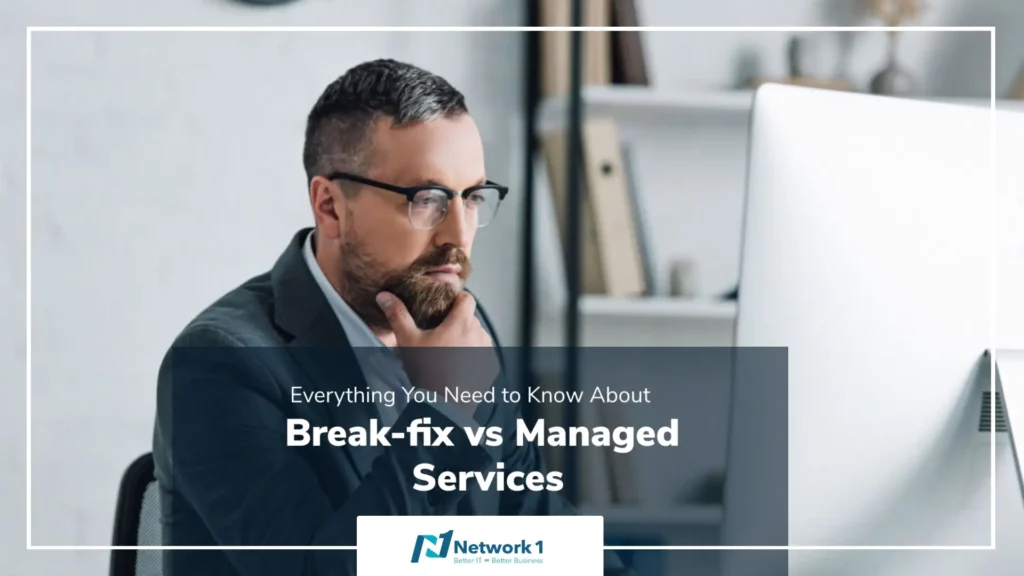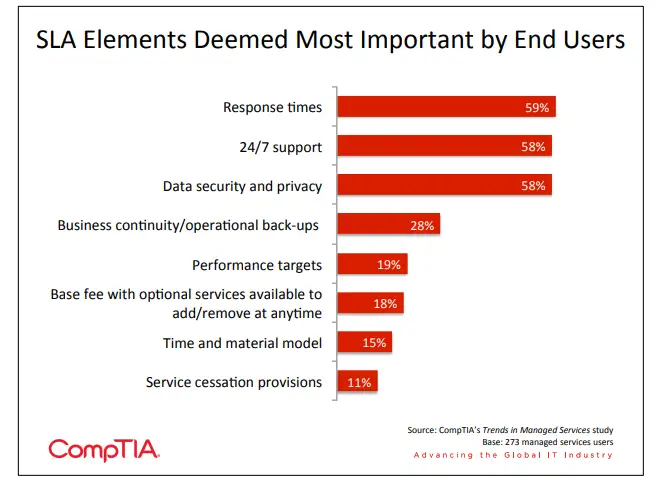 Most forward-thinking CIOs are not only managing their current IT challenges but also looking ahead to future advancements. This highlights the significance of IT management in an organization and underscores the importance of choosing the right IT support strategy for long-term business efficiency and cost-effectiveness.
Most forward-thinking CIOs are not only managing their current IT challenges but also looking ahead to future advancements. This highlights the significance of IT management in an organization and underscores the importance of choosing the right IT support strategy for long-term business efficiency and cost-effectiveness.
Regarding IT support, businesses often face a critical decision: opting for break-fix or managed services.
| As David Gracey, Founder & President of Network 1 Consulting, says, “The choice between break-fix vs managed services is not just about fixing technical issues; it’s about selecting a strategic partner that aligns with your business’s long-term goals and operational needs.” |
Understanding the differences between these two models is essential in ensuring that your IT infrastructure is not just a fix for today but a foundation for tomorrow.
Break-Fix Services: A Reactive Approach
The break-fix model is straightforward – you encounter an IT issue, you hire a professional to fix it, and you pay for that specific service.
This model might initially appear cost-effective, especially for businesses with less frequent IT issues. However, its reactive nature can lead to unpredictable costs and potential downtime, which might disrupt business operations.
| Looking for expert IT guidance? Make informed IT decisions with Network 1 Consulting by your side.Get Started |
Managed Services: A Proactive Approach
Managed services take a proactive approach. By partnering with a managed service provider (MSP), businesses pay a flat monthly fee to have their IT infrastructure continuously monitored and maintained. The managed services market has been seeing an upward trend in the last few years with its market size expected to grow to USD 372.6 billion by 2028.
This model anticipates issues and addresses them before they become critical, ensuring smoother business operations. It also allows businesses to predict IT expenses more accurately, making budgeting easier.
Break-Fix vs Managed Services: A Closer Look
| Aspect | Break-Fix Services | Managed Services |
| Cost Structure | Pay per service, unpredictable expenses | Flat monthly fee, predictable budgeting |
| Approach | Reactive, fix issues as they arise | Proactive, prevent issues before they happen |
| Downtime | Potential for longer downtime | Minimized downtime due to continuous monitoring |
| IT Planning | Short-term, immediate fixes | Long-term, strategic planning |
| Expertise Access | As-needed basis | Continuous access to expertise |
| Service Scope | Limited to specific issues | Comprehensive, covering a wide range of IT needs |
| Budgeting | Variable, can escalate unexpectedly | Fixed, easier to plan and manage |
Factors Affecting the Choice Between Break-Fix vs Managed Services
1. Company Size:
The size of a company plays a crucial role in determining the right IT support model.
- Small Businesses (less than 10 people): For small businesses with limited IT demands, the break-fix model might be more practical. These businesses often lack the financial resources to commit to a monthly fee and usually do not have complex IT systems that require constant monitoring.
- Medium to Large Companies (10 to 500 people): Larger businesses generally have more complex IT needs that cannot afford to be offline for any period. The managed services model is more suitable for these companies as it offers continuous monitoring and maintenance, ensuring minimal downtime and aligning with the scale of their operations.
2. Complexity of IT Infrastructure:
The complexity of your IT infrastructure is another determining factor.
- Simple Systems: Businesses with straightforward IT systems, such as those only needing basic computer and network maintenance, might find the break-fix model sufficient.
- Complex Systems: Managed services are often more beneficial for organizations with more intricate networks, a server (or multiple servers), or those relying heavily on cloud services. The complexity of these systems requires regular attention to prevent issues that could severely disrupt operations.
3. Criticality of IT in Operations:
How integral IT is to your daily operations also influences this decision.
- Less IT-Dependent Businesses: If a business can afford downtime without significant impact, the break-fix model might suffice. These businesses might not rely heavily on IT for their core operations.
- Highly IT-Dependent Businesses: Any downtime can be detrimental for companies where IT systems are vital — like most law firms, medical practices, financial services firms, construction companies and manufacturers.. Managed services ensure that these types of companies are always operational.
4. Budgeting and Financial Planning:
The financial strategy of a business is also a key factor.
- Predictable Budgeting: Managed services offer a predictable monthly expense, which makes budgeting easier. This model suits businesses that prefer fixed costs over variable ones.
- Variable Budgeting: The break-fix model might appeal to businesses with fluctuating cash flows or those preferring to pay for IT services as needed. However, this model can lead to unpredictable, sometimes higher, expenses during major IT issues.
5. Access to Expertise and Resources:
The level of expertise and resources needed is also important.
- In-House Expertise: Businesses with in-house IT teams might opt for break-fix services for specific, complex issues beyond their team’s expertise.
- Need for Continuous Expertise: Managed services provide ongoing access to a wide range of knowledge and advanced resources, beneficial for businesses without an extensive in-house IT team.
6. Long-Term IT Strategy and Growth Plans:
Finally, a company’s long-term IT strategy and growth plans can influence this decision.
- Short-Term Focus: Companies focusing on immediate, short-term goals might lean towards the break-fix model.
- Long-Term, Scalable IT Strategy: Businesses with a vision for growth and scalability often find that managed services align better with their long-term plans, providing the IT infrastructure needed to support expansion.
The Role of Service Level Agreements (SLA) in Managed Services
Service Level Agreements (SLAs) in managed services define the quality and scope of services a managed service provider (MSP) provides. These agreements specify the types of services offered, response times, performance metrics, and accountability measures.
SLAs ensure businesses receive consistent, reliable IT support tailored to their needs. They also establish clear expectations and foster trust and transparency in the partnership between the business and the MSP, making them essential for a successful and effective managed service arrangement.

Source: CompTia
Make the Right Choice With Network 1 Consulting By Your Side
The dilemma of break-fix vs managed services revolves around more than just immediate IT fixes; it’s about choosing a path that ensures resilience and growth in the ever-evolving business landscape.
| Explore our range of IT services in Atlanta:
|
This decision influences your current IT operations and sets the stage for future scalability and efficiency. If you’re considering the value a managed service provider can bring, reach out to Network 1 Consulting. With 25 years of experience as a leading MSP in Atlanta, we specialize in elevating your business’s IT infrastructure.
Reach out to us today to schedule a free consultation and proactively advance your IT strategy.






